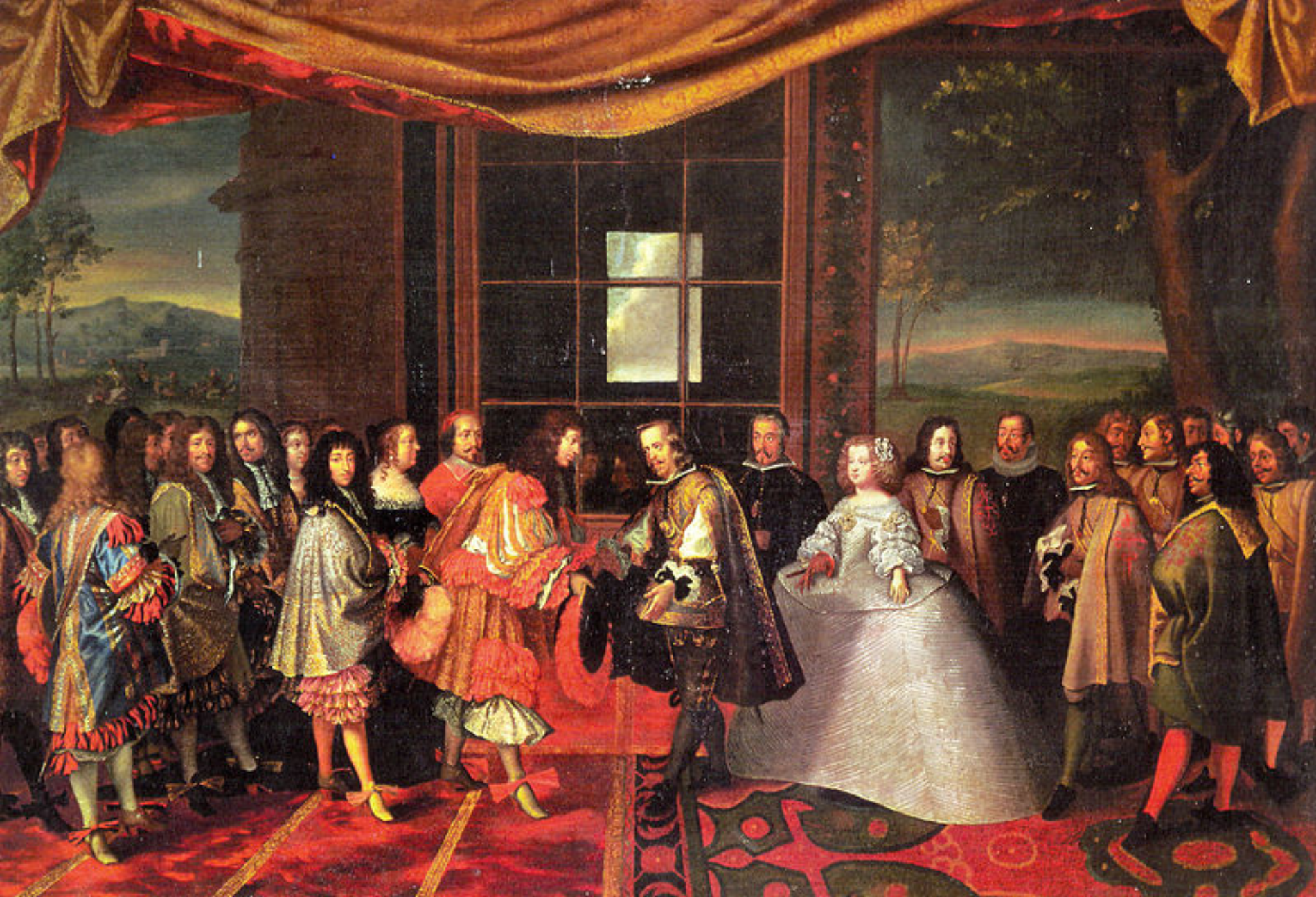The place was Donibane Lohitzune, in the French Basque Country, the date May 31st, 1660. 361 years ago. Diplomatic representatives of the Spanish and French monarchies signed their agreement on the precise line to be taken by the new border between their territories. Months before, on the island of the Faisans (07/11/1659), the Hispanics had agreed to cede to the French the dominions of Rosselló, Conflent and Vallespir - that is, most of the Catalan-speaking lands on the north side of the Pyrenees. And in that last round of negotiations, they also ceded Alta Cerdanya, from Vilar d’Ovança (now Montlluís) to La Guingueta d’Ix (called Bourg-Madame in French). That is to say, the head of the Segre river; clearly located on the southern slopes of the Pyrenees. The agreements of Donibane Lohitzune unmasked the false argument of the so-called natural frontier; defended, paradoxically, by the two diplomatic legations; and they revealed the Hispanic fear that Catalonia would follow in the footsteps of the Netherlands and Portugal - both territories formerly ruled by the Hispanic monarchies which went their own way.
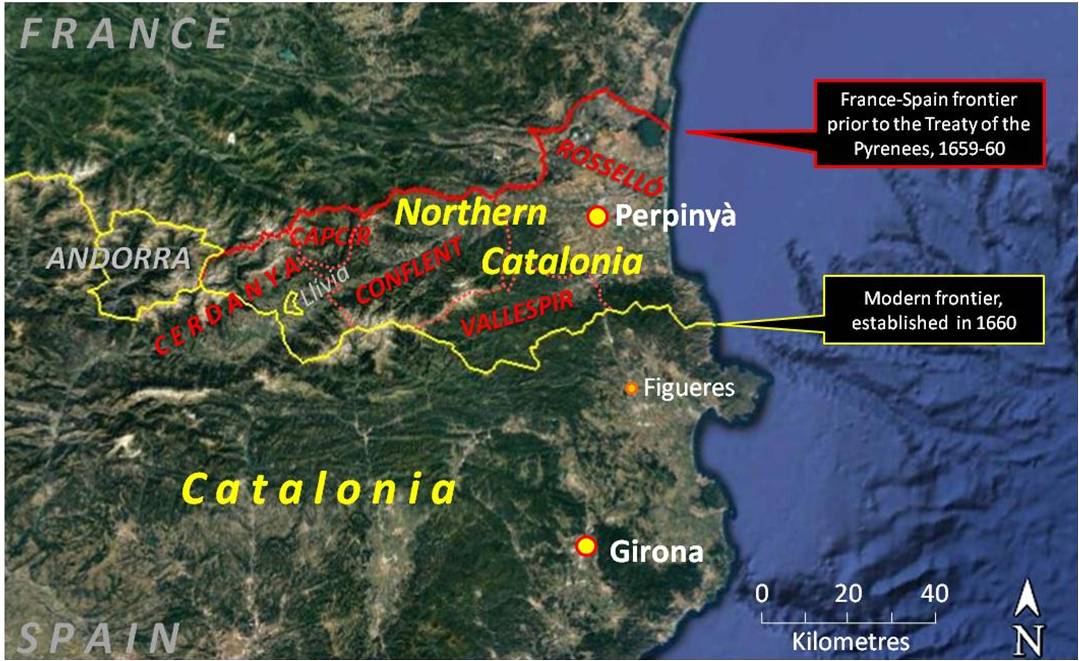
Northern Catalonia, showing the borders before and after the Treaty of the Pyrenees. In red, the Catalan 'comarques' (counties) ceded to France in 1659. Source: Google /R.S.
The Treaty of the Pyrenees was the culmination of a long political and military process that began with the Thirty Years' War (1618-1648); a conflict (like all conflicts) created deliberately, with the aim of resolving continental leadership. By the turn of the 1600s, the Spanish monarchy ("the empire on which the sun never sets") had entered a stage of crisis from which it would not emerge. Shipments of precious metals from the Americas (the lifeblood of the Hispanic economy) had fallen sharply: the depletion of the mines, and English and French corsair attacks showed that the imperial giant had feet of clay. But, above all, they had contributed greatly to uncovering the massive level of corruption that plagued all spheres of power in the Madrid court. A gigantic economic crisis that had precipitated an overwhelming political crisis.
Meanwhile, the French monarchy was in a trajectory that radically contrasted with the decline of its neighbours to the south. After the so-called Wars of Religion (1562-1598) that had wrought havoc across the country, the French rooster reappeared on European battlefields with its crest surprisingly re-manicured. Gone were the weighty problems that had impoverished and bled the country during the sixteenth century. The English had already left Gascony; and the internal struggles between the various branches of the royal lineage to relieve the decrepit Valois clan branch (conveniently disguised as a religious conflict) had also been resolved more or less to the satisfaction of all. In 1589, Henri Bourbon, the bloodiest ruler south of the Seine; proclaimed "Paris is well worth a mass," put his backside on the throne in Paris; and ushered in a period of relative internal peace and stability.
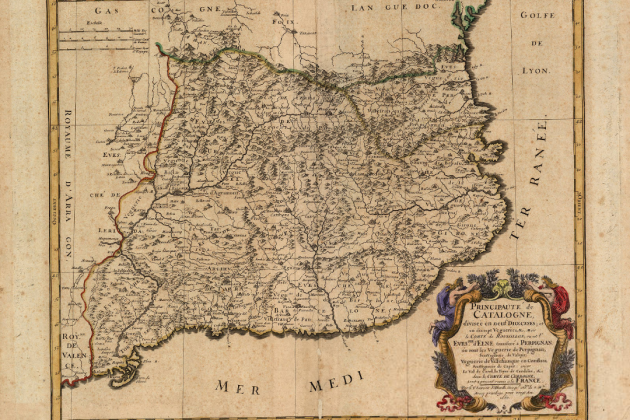
Map of Catalonia (1660) with the limits of the line of 1659 / Cartoteca de Catalunya
To understand what lay behind the Treaty of the Pyrenees one needs to look, above all, at the Hispanic and French evolution during the half century that began in 1600. By 1656, when the conversations that would lead to the Treaty of the Pyrenees began, the die had been cast. The Peace of Westphalia (1648), which ended the Thirty Years' War, the first great world war of the modern era, revealed a new scenario dominated by the Atlantic powers of France, the Netherlands, England, and Sweden. The fall of the Hispanic star would be confirmed with the final outcome of the particular confrontation between Madrid and Paris (1635-1659), with the Catalan revolt (1640-1652) as a backdrop. The Treaty of the Pyrenees was the Spanish diplomatic defeat that followed the military defeat of the Tercios, Spain's once-dominant military units, on the battlefields.
The latter is very important, as it unmasks the myth widely disseminated in Spanish pseudo-historiography that the "loss" of Rosselló and Cerdanya was due to "Catalan betrayal". The revolt in Catalonia had begun with the Reapers' War (1640), sparked by popular discontent at the Hispanic military occupation of Catalonia to fight the French. Pau Claris, president of the Generalitat of Catalonia, declared a Catalan Republic (17/01/1641), and shortly afterwards sought French aid and protection for it. However, in the proclamation of Louis XIII as Count of Barcelona by the Catalan institutions (23/01/1641) - and the same status accorded to his heir Louis XIV - the French monarchs behaved in Catalonia like elected princes, totally apart from their condition of kings of France. Thus, they neither incorporated Catalonia into France, nor alienated part of their territory for the benefit of the French monarchy. Between 1640 and 1652, Catalonia was an independent state that shared the figure of the monarch with France - and also with Navarra.
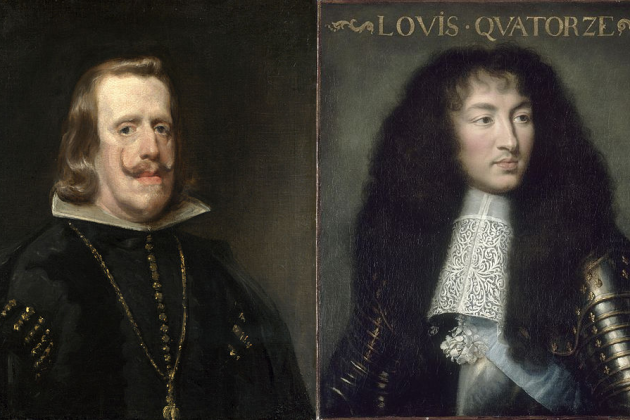
Portraits of Spain's Felipe IV and France's Louis XIV / Source: Prado Museum and Versailles Museum
In fact, it is also very important to mention that in the peace negotiations that would culminate in the Treaty of the Pyrenees, the French representatives had little interest in the northern Catalan counties. During the last phase of the Spanish-French conflict (from 1650), Hispanic troops had militarily reoccupied Catalonia. But the French leadership was very clear that it was sufficient for Louis XIV to retain — at least nominally — his status as count of Barcelona. Therefore, Cardinal Mazzarino, powerful minister of Louis, prioritized French demands towards other key Hispanic territories of the day: Franche-Comté, bordering Switzerland, and the Hispanic Netherlands. The French negotiating team conspired to gain control of present-day Belgium and Burgundy (the "Hispanic corridor" that surrounded and threatened France). Catalonia could wait.
So what happened to the French intentions? The records show that in that negotiating landscape, neither the Spanish monarchy had collapsed definitively, nor did the French monarchy have as much momentum as it hoped. Mazzarino, patient and practical, gave up on a total victory in exchange for a strategy of small gains he planned to make over time. In order not to waste the military victory by making the negotiating table endless, he accepted the Hispanic offer: the counties of Rosselló, Conflent and Vallespir; and southern parts of the large Hispanic territory in the Low Countries. It was November 7th, 1659, and that Hispanic "concession" was sealed with the agreement for the marriage of Louis XIV and María Teresa of Spain, daughter of the Spanish king Philip IV; which, four decades later, would pave the way for a Bourbon to sit on the throne in Madrid (1701).
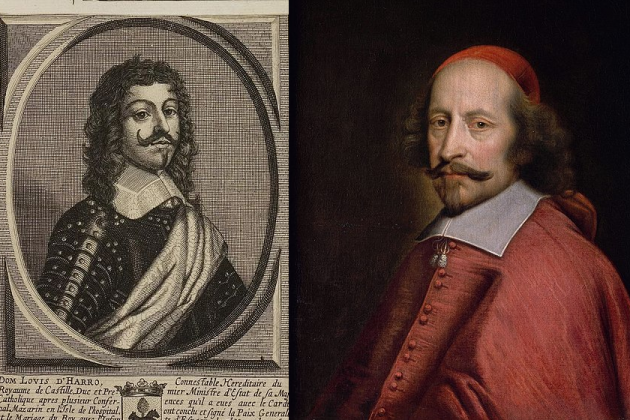
Representations of Luis de Haro and Cardinal Mazzarino (circa 1660) / Source: University of Heildelberg and Condé Chantilly Museum
On the other hand, the approach of the Spanish negotiating team was quite the opposite: documentary sources reveal that it was made up of eccentric and grotesque characters, led by the court favourite Luis de Haro, who were always a step behind the initiatives of Mazzarino. Not only did they have no geographical idea about the Pyrenees; rather, they were only moved by a punitive ideology against Catalonia, which had prevailed at the court of Madrid since the Revolution of 1640. And while the country's leaders during the "French" stage played a very prominent role in the negotiating table (this is the case of Ramon Trobat or Pierre de Marca), Luis de Haro, due to an obvious and manifest question of distrust, contribute very little in the eyes of the few Catalans who had been loyal to the Hispanic king Felipe IV.
In 1660, Mazzarino, in line with his strategy of small victories, managed to reopen negotiations and demanded the transfer of control of the entire Cerdanya and Urgellet (the upper valley of the key south-flowing river, the Segre, as far as La Seu d'Urgell). The earlier pretext of locating the border on the ridges of the Pyrenees (and restoring the Roman defence lines that more than a thousand years earlier had separated Gaul and Hispania) was left discarded as a nonsense and French negotiators even argued that Catalonia, in its totality, had Frankish origins. That strategy did not restore the balance of 1640; but, on the other hand, Mazzarino managed to move the frontier southwards from Montlluís to La Guingueta: he incorporated the Alta Cerdanya, that is, the headwaters of the Segre river, into the French domain; territory which is clearly on the south side of the Pyreneam divide.
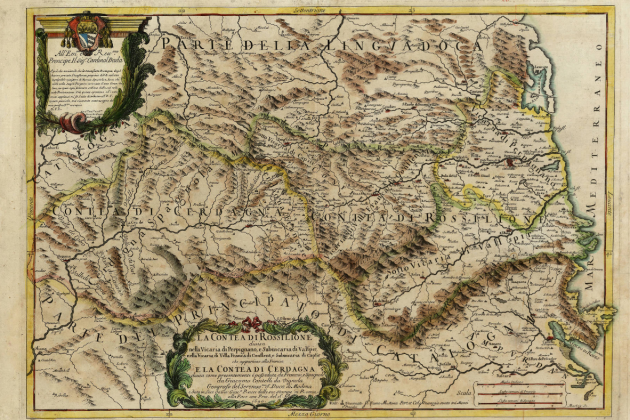
Map of the northern Catalan counties (1690) / Source: Cartoteca de Catalunya
The sad role of the Catalan leaders who were in power by this time was the last straw which ensured the definitive amputation of the northern Catalan counties. After the 1652 Hispanic military re-occupation of Catalonia, Felipe IV did not destroy Catalan self-government; but he put the institutions of the country under the control of the chancellery of Madrid. He purged political powers, and opponents of the Hispanic regime were replaced by a horrible pack of sycophants: like an Article 155, but with baroque music, the collaborators were put in power. The amputation of the northern Catalan counties was totally illegal; but, on the other hand, in the publications of the government of the Generalitat of Catalonia there are only a few notes referring to timid protests. The Treaty of the Pyrenees was the price of the punishment that the Hispanic king Felipe IV imposed on Catalonia for the Revolt of 1640.

